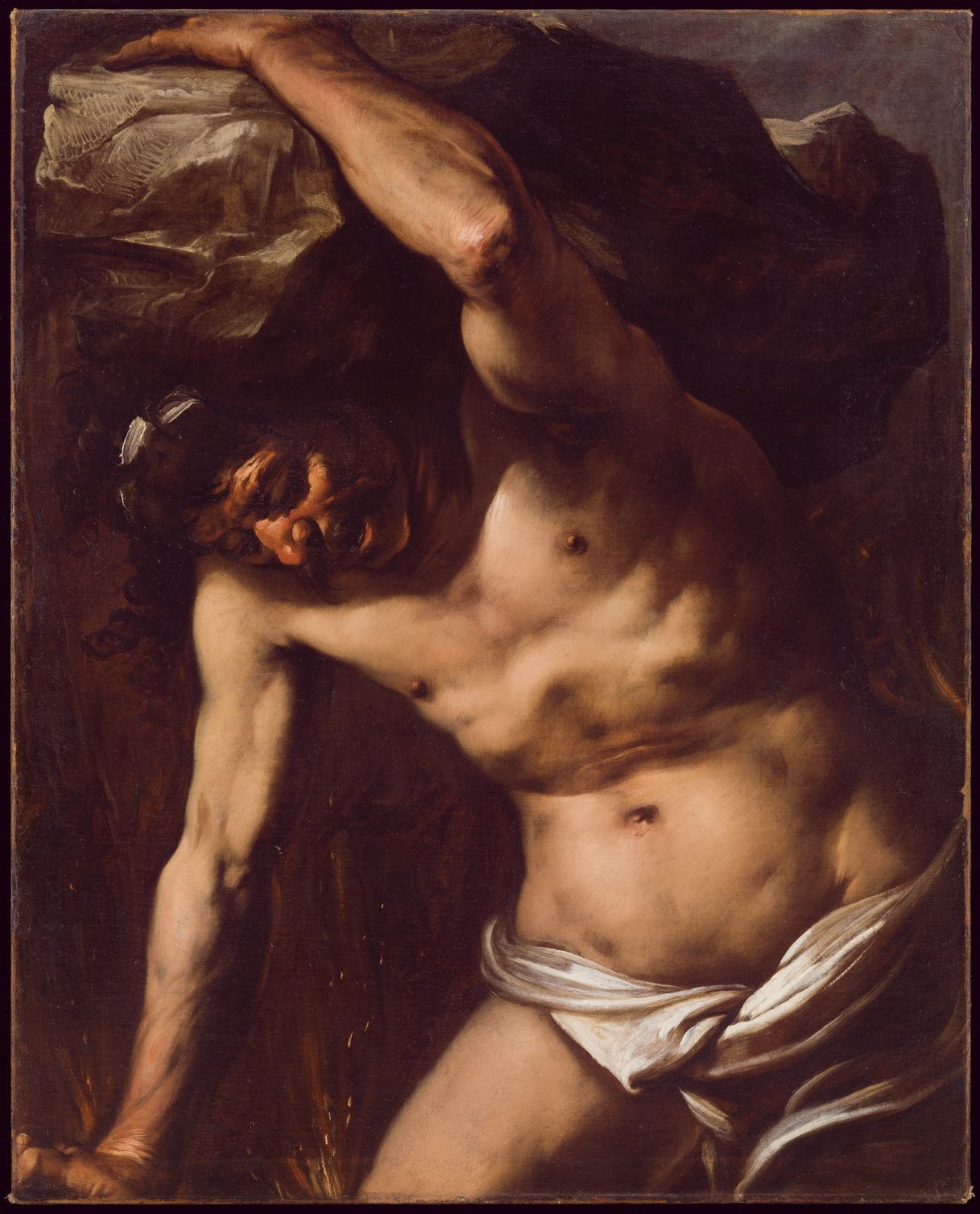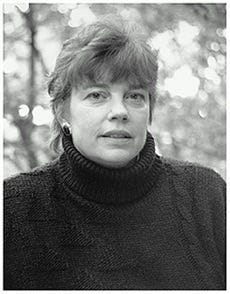The Real Life of Mythical Toil
Painters, poets, and philosophers have seen many things in the myth of Sisyphus. They have seen an image of the absurdity of human life, the futility of effort, the remorseless cruelty of fate, the unconquerable power of gravity. But they have seen too something of mankind's courage, resilience, fortitude, endurance, and self-belief. They see something in our refusal to submit.
Stephen Fry, Mythos
Sisyphus literally cheated death, making the Greek gods increasingly frustrated. He was not a stellar citizen. As king of Corinth, his treacheries knew no bounds. He conjured up ways to outsmart the gods with deceit and trickery. Exasperated, they entrusted Thanatos – the original grim reaper – to finally put an end to his selfish treachery. But they didn’t appreciate the creative bounds of his perfidy.
Thanatos had special chains with him to bind and bring Sisyphus to the underworld. Instead Sisyphus skillfully fooled his potential captor into becoming captive in his own chains. The gods only became aware something had gone wrong with their plans after the dead quit showing up at the River Styx to cross over to Hades. Death it seemed, had indeed taken a holiday.
Chaos soon flourished on earth. Warriors didn’t die on the battlefield. Revelers could drink unprecedented amounts of wine without fearing the consequences of liver failure. The gods searched for Thanatos. Upon finding and releasing him, Thanatos begged for one more chance, which was reluctantly granted. But Sisyphus hatched a successful plan to let him live another fifty years.
Nearing the end of his mortal days, Sisyphus had one more ruse in mind: to fool the gods into making him immortal. The third visit was more of a charm for Thanatos. The crossing into Hades was uneventful. Hermes, the messenger of the gods, welcomed Sisyphus to the underworld, complementing him on having outsmarted death twice. Knowing Sisyphus craved the immortality of the gods, Hermes offered him a path to achieve it.
All Sisyphus had to do was roll a large boulder up an incline – it looked more than manageable to him – from Hades to a hole at the top, which led to the Elysian Fields and everlasting immortality. It looked easy enough. But the gods made sure Sisyphus would lose his grip and footing just as he approached the hole. The boulder rolled down, forcing Sisyphus to start all over, always with the same result. According to mythology, he still toils today, as he will tomorrow and forever. His immortality became an everlasting curse.
Countless cancer patients throughout history could relate to the brutal frustration of a Sisyphean torment. But unlike Sisyphus, they did nothing to deserve it. Instead of angry gods, their tortures were directed by mindless, aggressively proliferating malignant cells. Francesca “Cesca” Thompson didn’t have to know about Greek mythology to understand that.
Kenneth Anderson can still visualize his first meeting with Cesca at his Dana-Farber Cancer Institute office in Boston. “She was a young, vibrant, orthopedic surgeon, looking for something new. She was medically attuned and very well educated,” he said (much the same as Jean-Luc Harousseau’s recollection of his first myeloma patient), “and she knew that the standard of practice was not going to give adequate benefit. So she was highly motivated.” She also knew, as Anderson himself conceded, “we had largely ineffective chemotherapy at that time.” Moreover, “she had advanced myeloma and her predicted survival was very short, one-to-two years.”
The diagnostic tests confirmed “she had extensive multiple myeloma, Durie Salmon Stage 3 back in those days, which is no longer used for staging disease anymore.” Although Anderson, as Cesca wrote in Going for the Cure, was “a young researcher” and the proposed procedure had never been tried on any myeloma patient before, she trusted him.
Anderson’s protocol built on the work of Tim McElwain in the United Kingdom who “actually, I think, should be credited with the first real breakthrough, the use of high-dose melphalan and autologous marrow rescue” which demonstrated “very significant depth of response, what we back then used to call complete response.” It was a “paradigm shift.” Anderson and Bart Barlogie, then at MD Anderson, “were doing it in parallel, it was really the first time that meaningful complete response could be achieved in myeloma.”
Cesca “was the first person here to undergo high-dose melphalan followed by autologous marrow transplant,” Anderson explained, “in our Center, the autologous marrow was cleansed or purged of myeloma using monoclonal antibodies to remove or deplete the myeloma before the bone marrow was given back. Those monoclonal antibodies we made in the laboratory. It was called purged autologous marrow.”
Anderson said Cesca embodied “one important point: it’s really critical that patients have a very positive mindset, an idea that they’re going to do everything they can on their part to make this a success.” That also means keeping a routine. “As an orthopedic surgeon, she focused her work on the foot. That was her primary interest. She wrote clinical papers, did a lot of teaching, and served as a role model.”
Their bond went far beyond a typical doctor-patient relationship. “We became fast friends,” said Anderson, smiling as a memory came back. “One morning she called, ‘Ken, I’m going to be on television! I’m going to be on the Today show because I wrote a paper on a study that showed the length and width of women’s feet are not at all correlated with the length and width of women’s shoes!”
Soon they became a team. “She and I used to give talks together after her transplant and she fully went back to work,” said Anderson, “I would talk about this new procedure in myeloma and update people about stem cell transplant. She would be talking about the bone complications of myeloma, which she knew about more than anybody because she knew bone disease and she was an example as a patient.”
Cesca died on February 15, 1996. It was two days before her fifty-second birthday, nine years and three days after her transplant – when the average survival with myeloma was two years or less.
I asked Anderson to compare, if Cesca were diagnosed today, how different her experience might be.
“If she were to come today,” Anderson answered, “she would get a four drug combination of these novel therapies – lenalidomide, bortezomib, dexamethasone, and daratumumab, the monoclonal antibody – to reduce her myeloma. She would not have bone marrow grade collected, but peripheral blood stem cells instead. Then she would come in and she get the same melphalan.” Transplant “would be followed by maintenance of two drugs, daratumumab and lenalidomide,” likely leading to “an unprecedented response rate. It's something on the order of 70 to 80 percent what we call MRD-negative [minimal residual disease] complete response.”
When Cesca had her transplant in 1987, “there was no maintenance treatment after transplant, we didn't have any ability to maintain the benefit from the transplant afterwards.” Plus she had total body irradiation, which the Intergroupe francophone du myélome (IFM) proved to be inferior to high-dose melphalan alone in the early 1990s and is now obsolete.
“Advances have made transplantation better in two ways,” he continued, “the efficacy and unprecedented duration of response, and it’s been made much safer. It turns out when we transplanted with bone marrow cells, they take longer to recover than peripheral blood stem cells. So the risk time for infection is much shorter. We have growth factors if they're needed to fertilize the blood cells, which we didn't have back then. So it's night and day, but the paradigm, the framework, for doing transplantation really is a refinement or a continual evolving improvement in what started right around the early 80s.”
Moreover, Anderson concluded, “Francesca did not have high-risk disease. So the predicted benefit she would get at least approaches a decade without active myeloma. And many people have a normal lifespan.” Cesca might have, as she hoped for in the conclusion of Going for the Cure, grown old and died of something unrelated to myeloma.
Anderson’s life changed dramatically. When Cesca first went to Dana-Farber, she was a bit concerned that myeloma was not listed in a brochure as one of their specialties. That’s changed. Dana-Farber’s Jerome Lipper Multiple Myeloma Center and Lebow Institute for Myeloma Therapeutics, founded and led by Anderson, make the cancer institute one of the top myeloma specialty centers in the world. Staffed by numerous experts including Paul Richardson, Nikhil Munshi, Irene Ghobrial as well as a large cadre of treating physicians and researchers who will be the leaders for decades to come, myeloma without Dana-Farber would be unthinkable.
Top myeloma experts throughout the United States and every continent learn and train under Anderson and his staff; the list is long and we’ll be learning about many of them in future articles. Dana-Farber’s clinical research and patient care nurses rank among the best and most experienced anywhere.
Anderson served as president of the American Society of Hematology in 2017 and succeeded Robert Kyle as the second president of the International Myeloma Society (IMS). He received the most prestigious lifetime honor in myeloma, the IMS’s Waldenström Lifetime Achievement Award in 2003. The list of his honors and achievements could fill a small book. And he’s still as active and engaged as ever.
In 2020, Anita D’Souza from the Medical College of Wisconsin and her colleagues published a retrospective study, Current Use of and Trends in Hematopoietic Cell Transplantation in the United States. The paper included a graph showing the total number of allogeneic and autologous transplants, regardless of disease indication, that had been performed in the U.S. from 1980 to 2019.
The line for allogeneic transplants largely represents lymphoma and leukemia – there have been comparatively few in myeloma – reflecting the validity of Don Thomas’s ideas. The line for autologous transplants shows nothing happening until a slight, barely recognizable rise in the line can be seen starting in 1987. That’s Cesca.
The steep rise from through 1998 is represented almost entirely by myeloma, reflecting the seminal influence of Barlogie and Anderson. The initial steep rise in the number of autologous transplants was made possible because of the investments medical institutions made to capitalize on Thomas’s breakthroughs.
The steep decline occurring from 1998 to 2000 is a story for another day. But the overall trend since 2000 shows, despite the promise that drug regimens might one day replace transplants, the continued use and efficacy.
Cesca was the first of hundreds of thousands patients and hundreds of thousands more who have no idea they too will have one in their futures. Also missing are the experiences of more myeloma patients on every continent who have had transplants.
It’s a safe bet none of them have ever heard of Francesca Thompson. They should. Especially if they feel like they see something of themselves in the myth of Sisyphus.
Photo: Detail, Sisyphus (ca. 1660), Giovanni Battista Langetti, Detroit Institute of the Arts






